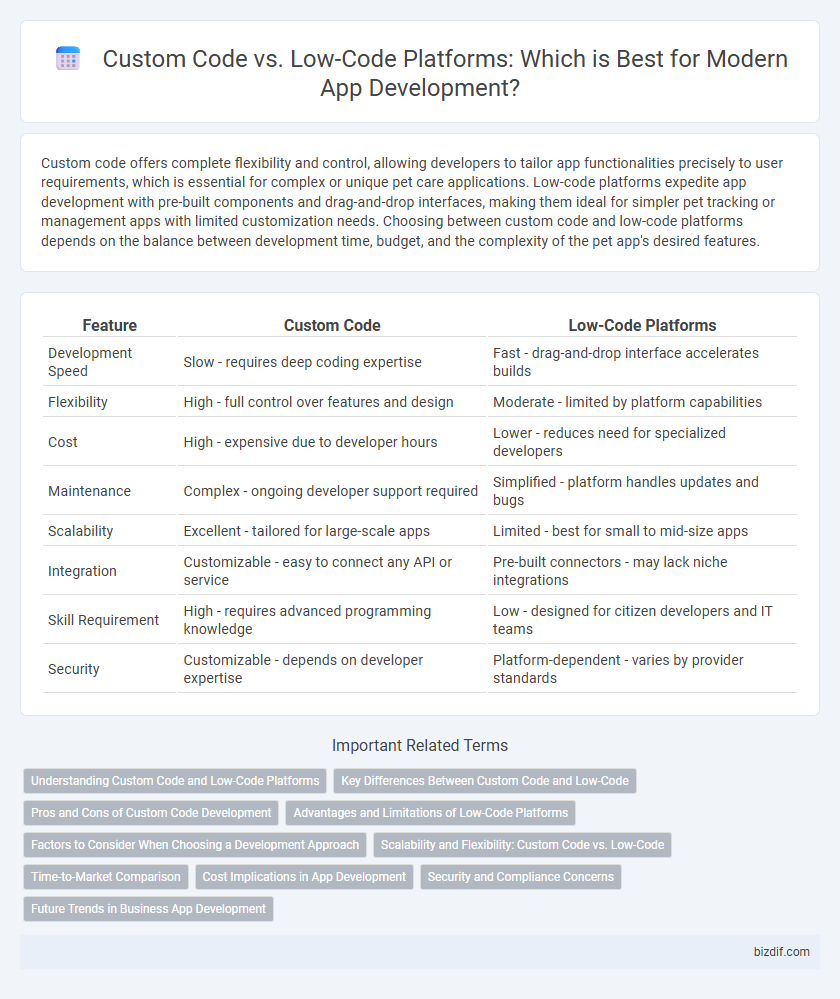Custom code offers complete flexibility and control, allowing developers to tailor app functionalities precisely to user requirements, which is essential for complex or unique pet care applications. Low-code platforms expedite app development with pre-built components and drag-and-drop interfaces, making them ideal for simpler pet tracking or management apps with limited customization needs. Choosing between custom code and low-code platforms depends on the balance between development time, budget, and the complexity of the pet app's desired features.
Table of Comparison
| Feature | Custom Code | Low-Code Platforms |
|---|---|---|
| Development Speed | Slow - requires deep coding expertise | Fast - drag-and-drop interface accelerates builds |
| Flexibility | High - full control over features and design | Moderate - limited by platform capabilities |
| Cost | High - expensive due to developer hours | Lower - reduces need for specialized developers |
| Maintenance | Complex - ongoing developer support required | Simplified - platform handles updates and bugs |
| Scalability | Excellent - tailored for large-scale apps | Limited - best for small to mid-size apps |
| Integration | Customizable - easy to connect any API or service | Pre-built connectors - may lack niche integrations |
| Skill Requirement | High - requires advanced programming knowledge | Low - designed for citizen developers and IT teams |
| Security | Customizable - depends on developer expertise | Platform-dependent - varies by provider standards |
Understanding Custom Code and Low-Code Platforms
Custom code development involves creating software through traditional programming languages, offering full control and flexibility for complex, tailored applications. Low-code platforms provide visual development environments with pre-built components, enabling faster deployment and ease of use for users with limited coding skills. Choosing between custom code and low-code depends on project requirements, scalability needs, and resource availability within app development.
Key Differences Between Custom Code and Low-Code
Custom code offers full flexibility and control by allowing developers to write precise programming instructions tailored to specific app functionalities, while low-code platforms provide visual development tools and pre-built components that accelerate app creation with minimal hand coding. Custom coding suits complex, unique applications requiring deep customization, whereas low-code platforms optimize for rapid deployment and ease of use in standard business solutions. Key differences include development speed, level of customization, required technical skills, and scalability potential.
Pros and Cons of Custom Code Development
Custom code development offers unparalleled flexibility and control, enabling developers to create highly tailored applications that precisely meet complex business requirements; however, it demands significant expertise, time, and resource investment, resulting in higher development and maintenance costs. This approach ensures better performance optimization and security customization but can lead to longer time-to-market compared to low-code alternatives. Enterprises seeking unique solutions and scalability often prefer custom coding despite the challenges of managing ongoing updates and debugging issues.
Advantages and Limitations of Low-Code Platforms
Low-code platforms accelerate app development through visual interfaces and pre-built components, enabling faster deployment and reduced coding expertise requirements. These platforms limit customization and may face scalability challenges, potentially restricting complex functionality and integration capabilities. Low-code solutions best suit rapid prototyping, simple workflows, and businesses seeking to minimize development costs while sacrificing granular control.
Factors to Consider When Choosing a Development Approach
Evaluating factors such as project complexity, budget constraints, and development speed is crucial when choosing between custom code and low-code platforms. Custom code offers extensive flexibility and scalability for intricate applications, whereas low-code platforms accelerate deployment with pre-built templates and simplified drag-and-drop interfaces. Security requirements, maintenance capabilities, and integration needs also influence the optimal development approach for your app project.
Scalability and Flexibility: Custom Code vs. Low-Code
Custom code offers unmatched scalability and flexibility, enabling developers to build complex applications tailored precisely to specific business requirements and adapt seamlessly to changing demands. Low-code platforms provide faster deployment with pre-built components but often face limitations in customization and scalability when handling large-scale or highly specialized projects. Organizations aiming for long-term growth and unique functionalities benefit more from custom-coded solutions, while low-code platforms suit rapid prototyping and simpler applications.
Time-to-Market Comparison
Custom code development often requires significantly more time-to-market due to extensive coding, testing, and debugging processes, especially for complex applications. Low-code platforms accelerate delivery by providing pre-built components and drag-and-drop interfaces, reducing development cycles from months to weeks or even days. Enterprises leveraging low-code solutions achieve faster deployment, enabling quicker iteration and faster ROI compared to traditional custom development.
Cost Implications in App Development
Custom code development often incurs higher upfront costs due to the need for skilled developers and extended development timelines, but offers greater flexibility and scalability. Low-code platforms reduce initial expenses by providing pre-built components and faster deployment, making them ideal for small to medium-sized projects with limited budgets. However, ongoing licensing fees and potential limitations in customization may increase long-term costs compared to fully custom solutions.
Security and Compliance Concerns
Custom code development offers granular control over security protocols, enabling tailored measures to meet specific compliance standards such as GDPR and HIPAA. Low-code platforms streamline app creation but may introduce vulnerabilities due to limited customization in security features and reliance on third-party components. Businesses must evaluate platform certifications, data encryption methods, and audit capabilities to ensure adherence to industry regulations.
Future Trends in Business App Development
Future trends in business app development highlight a growing shift toward low-code platforms due to their speed, scalability, and ease of integration with AI and automation tools. Custom code remains critical for highly specialized applications requiring tailored functionality and deep system integration, particularly in industries with complex regulatory requirements. Hybrid approaches combining low-code development with custom extensions are becoming dominant, enabling rapid deployment while maintaining flexibility and control over business-critical processes.
Custom Code vs Low-Code Platforms Infographic

 bizdif.com
bizdif.com